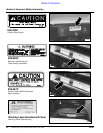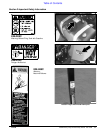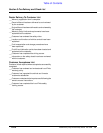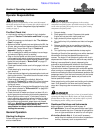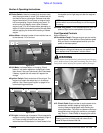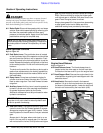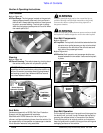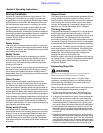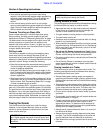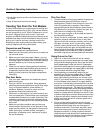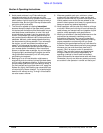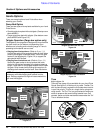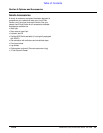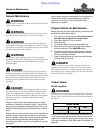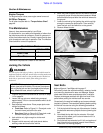
Section 4 Operating Instructions
4400EX Heavy Duty Off Road Utility Vehicle 720-132M
7/01/05
18
Table of Contents
Driving Conditions
Terrains vary creating different driving situations. The
following are circumstances you might encounter and
suggestions on how to operate the Gondo safely. Always
approach each new situation with extreme caution until
you have become experienced in handling your vehicle.
We recommend for your safety and the safety of others
that you allow only operators experienced in driving a
standard transmission, understandall potential dangers of
operating this vehicle, has studied this manual, viewed the
video safety tape supplied with this vehicle and has
received actual hands-on instructions from an
experienced operator.
Sandy Terrain
Tires with high air pressure perform better in loose sand.
Also, stay in low gear to avoid spinning the wheels. Always
maintain vehicle control, don’t make sharp turns and avoid
hard braking when possible.
Muddy Terrain
Better traction is achieved by accelerating the vehicle
slowly to avoid spinning the wheels. Making sharp turns
and hard braking can cause the vehicle to skid out of
control. Let up on the accelerator pedal and stop when
skidding out of control.
Clean off mud residue stuck to rotating drive shafts and to
the tires as quickly as possible. Mud clinging to rotating
parts causes and imbalance that can damage vehicle
components. Also clean the brake drums of mud to reduce
premature brake wear.
Watery Terrain
Always determine the depth of water before driving
through it. Do not drive through water that is higher than
the bottom of the floor board. Always enter the water
slowly and continue traveling slowly through the water to
minimize splashing. The vehicle could stall if the electrical
system gets wet. Never allow water to get up around the
engine. A wet engine is likely to stall or become damaged.
Test the brakes for stopping capabilities once through the
water. Allow the brakes to dry before proceeding if braking
capabilities are reduced. Brakes can be dried faster by
driving the vehicle slowly on a level surface while applying
light pressure to the brake pedal.
Snowy and Icy Terrain
Like muddy terrain, accelerate the vehicle slowly to avoid
spinning the wheels. Avoid making sharp turns and hard
braking. Let up on the accelerator pedal and stop when
skidding out of control. Always maintain a steady slow
speed allowing time to slow down and stop. Remember
slick surfaces require more time to slow down, make turns
and stops.
Uneven Terrain
The Gondo’s center articulating steering enables the four
driving wheels to maintain contact in various uneven
terrain situations. Because of this, the vehicle is capable of
maneuvering over rough surfaces, up and down steep
inclines. Avoid operating on excessively steep hills and
especially on hills that are steeper than 15 degrees.
Climbing Steep Hills
Always approach a steep hill straight on in 1st (low gear) to
reduce engine strain and minimize stalling. Continue
straight up the hill in low gear moving right or left only to go
around obstacles. Do not attempt to turn the vehicle
around during a steep climb. If the vehicle stalls or should
you decide to stop the climb, place vehicle in reverse gear
and back down the hill slowly and as straight as possible to
a safe location. If needed, apply the brakes very lightly to
assist slowing down vehicle’s descent. Hard braking can
cause total loss of control and a rollover situation. Don’t
depress the clutch while backing down except when
bringing the vehicle to a complete stop.
Maximum traction and control is achieved while traveling
up a steep incline in 1st gear at the lowest possible speed.
Also traveling slowly allows more time to correct a
dangerous situation.
Descending Steep Hills
!
WARNING
Do not descend a steep hill with rear cargo box removed.
Dangerous forward weight distribution is created.
Descend most hills straight down in 1st gear. When
necessary, use steady pressure on the brakes without
locking them up. Hard braking can cause total loss of
control and a rollover situation.
Always consider ground conditions and load distributions
as outlined below before descending a steep hill:
• Is the ground surface wet or dry? Wet surfaces can
result in loss of control and should not be attempted.
• Is the ground surface firm or loose? Loose surfaces can
result in loss of control and should not be attempted.
• Is the terrain fairly even or is it eroded and uneven with
holes and boulders? Surfaces that are not fairly even
can result in loss of control and should not be attempted.
• Can the descent be made fairly straight or will you be
required to turn to a degree that is approaching cross-
hill travel making the vehicle subject to imbalance and
turning over.
• Consider the vehicle’s center of gravity. Is it front heavy,
loaded high with cargo and is there a passenger along
adding weight over the front axle? The rear axle should
have sufficient weight over it to counter balance weight
distributed over the front axle. A vehicle with poor center
of gravity is subject to flipping forward end over end.



